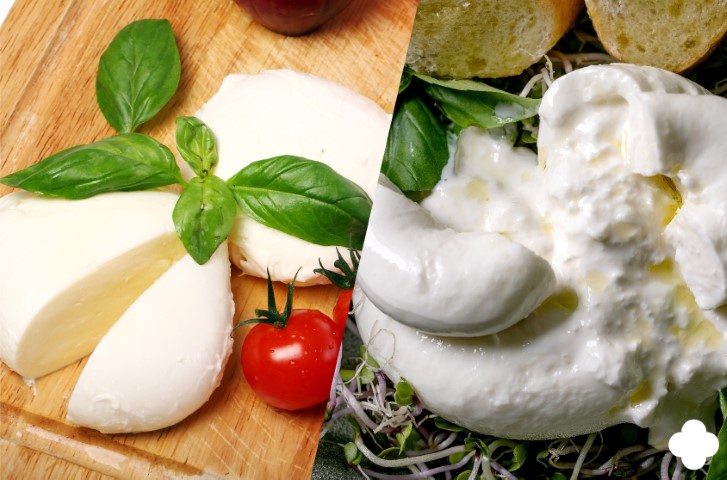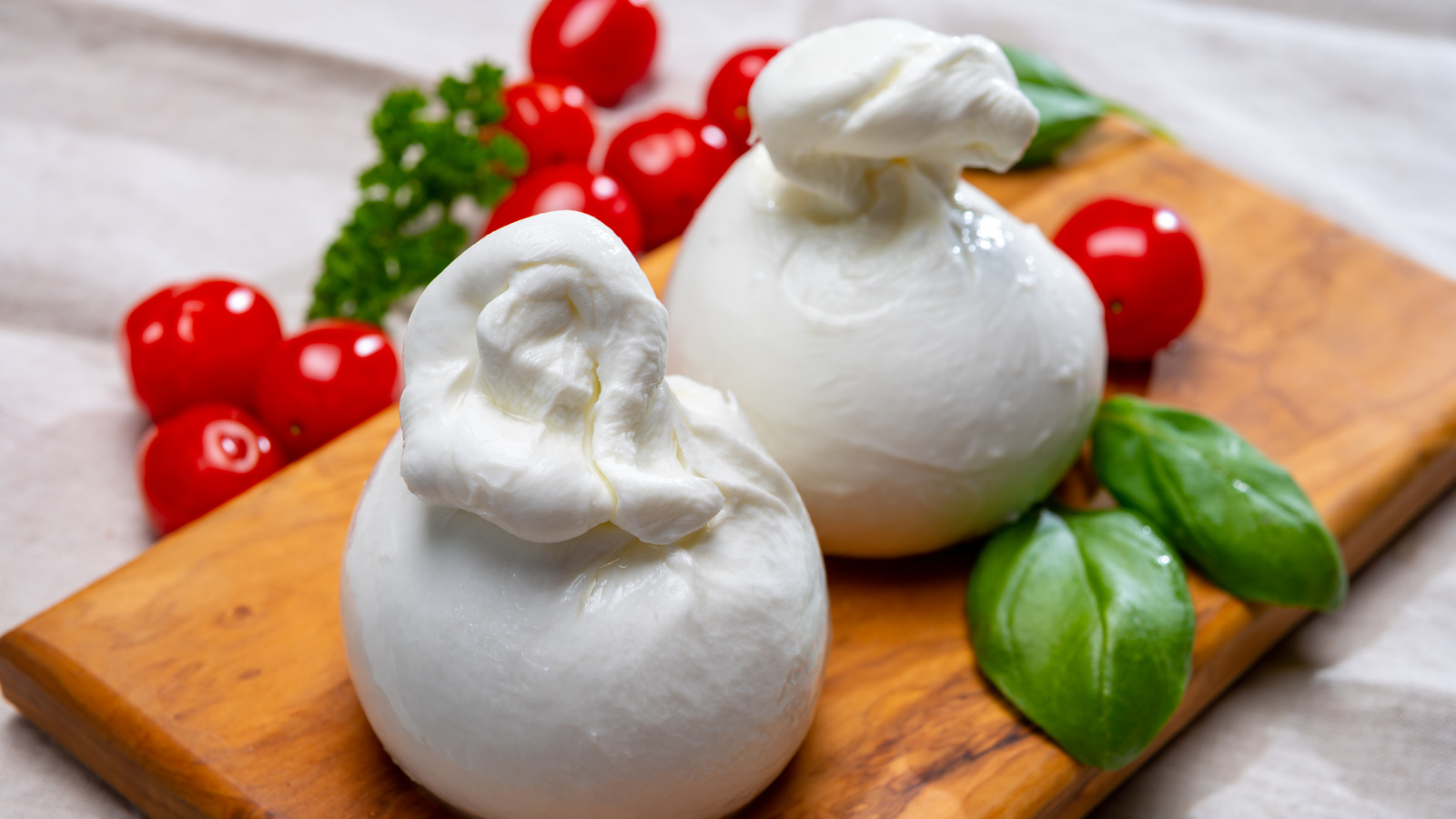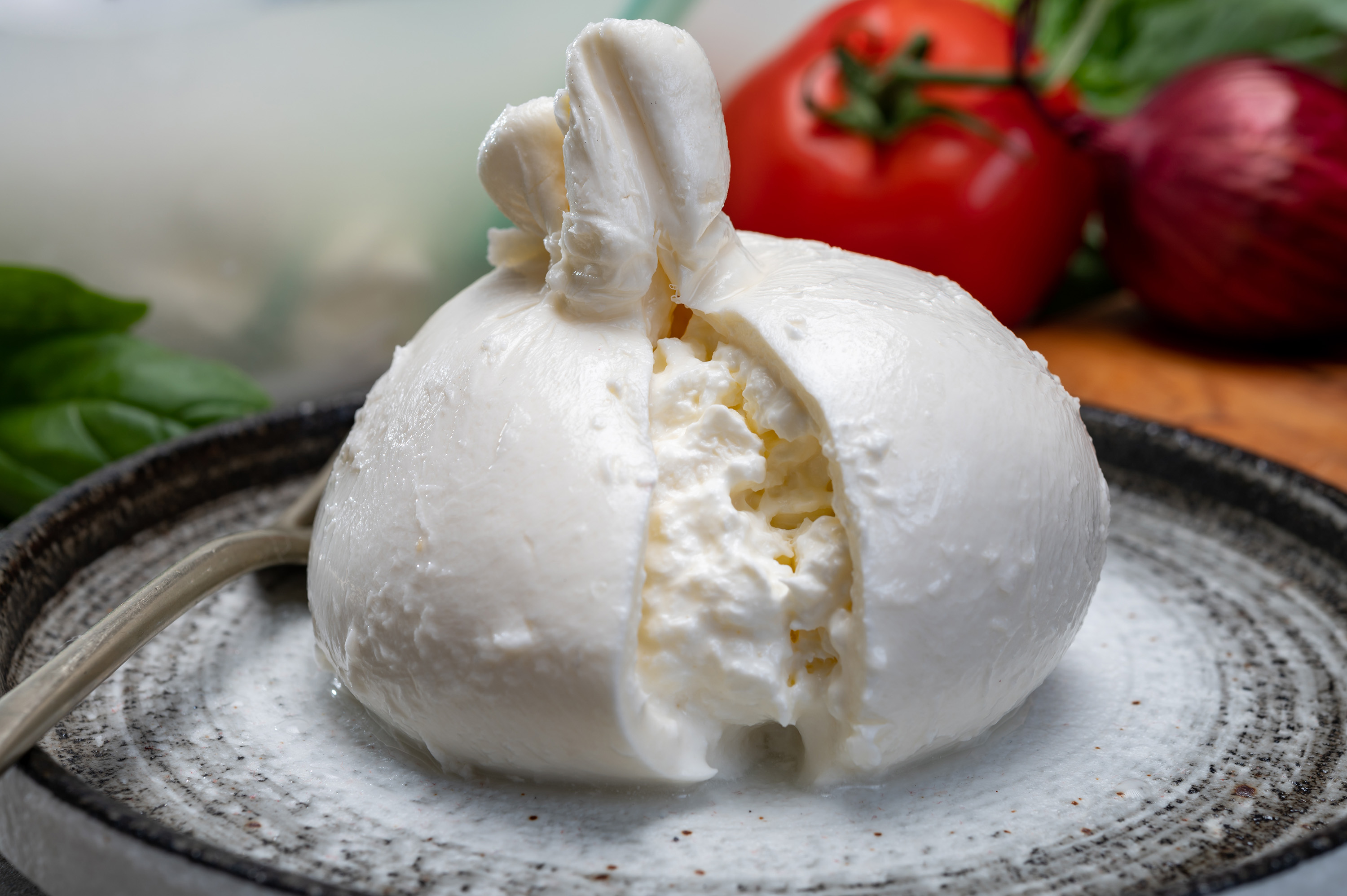Introduction

Burrata cheese and mozzarella are two distinct fresh cheeses that are popular in Italian cuisine. While they may appear similar, they have distinct differences in taste, texture, and production process. Burrata cheese is known for its creamy and indulgent center, created by filling a thin pouch of mozzarella with soft stringy curd and cream. On the other hand, mozzarella has a firm and elastic texture, perfect for slicing and melting. Understanding the differences between these two cheeses can help in choosing the right one for various culinary creations. So, let’s delve into the details of burrata cheese versus mozzarella and explore their unique characteristics.
Overview Of Burrata Cheese And Mozzarella
Burrata cheese and mozzarella are both fresh Italian cheeses known for their creamy and indulgent flavors. While mozzarella is firm and elastic, perfect for slicing and melting, burrata stands out with its delicate and luscious center. Burrata is made by filling a thin pouch of mozzarella with soft stringy curd and cream. This process creates a unique contrast in textures, with the firmer outer pouch and the creamy spreadable inside. Mozzarella, on the other hand, is made using the traditional method of stretching curds and is widely used in various culinary dishes.
Key Differences Between Burrata Cheese And Mozzarella
Burrata cheese and mozzarella may share a similar origin, but they differ significantly in texture and taste. The main difference lies in their production process and the addition of creamy filling in burrata cheese. While mozzarella is known for its firm and elastic texture, burrata stands out with its soft and creamy center. Additionally, burrata offers a unique contrast in textures with its firmer outer pouch and the creamy spreadable inside, while mozzarella remains consistently smooth throughout. These differences make each cheese suitable for distinct culinary uses and flavor profiles.
Burrata Cheese

Burrata cheese is a delicious Italian cheese known for its rich and creamy taste. It originated in the Puglia region of Italy and is made from fresh cow’s milk. The production process involves forming a pouch with stretched mozzarella cheese and filling it with a combination of soft curd and cream called stracciatella. The result is a cheese with a soft and luscious texture that melts in your mouth. Burrata cheese offers a unique contrast in textures, with a firmer outer pouch and a creamy, spreadable inside. It is commonly used in salads, pasta dishes, and as a topping for pizzas.
Burrata Cheese: Origin And Production Process
Burrata cheese originated in the Puglia region of Italy and was first produced in 1956 by Lorenzo Bianchino in the town of Andria. The production process of Burrata cheese involves the use of fresh cow’s milk. The cheese makers start by forming a pouch using stretched mozzarella cheese. They then fill this pouch with a combination of soft curd and cream called stracciatella. The pouch is sealed, resulting in a cheese with a unique texture, with a firm outer layer and a creamy, spreadable inside.
Burrata Cheese: Taste And Texture
Burrata cheese is known for its rich and creamy taste, making it a favorite among cheese lovers. Its texture is unique, with a firm outer layer that gives way to a creamy and spreadable center. When you bite into a piece of Burrata, you will experience the smooth and velvety texture of the curd and cream filling, which adds a luscious and indulgent element to each bite. The combination of the soft and creamy interior with the firmer outer layer creates a delightful contrast that adds to the overall enjoyment of this cheese.
Mozzarella

Mozzarella is a traditional Italian cheese that is well-known for its versatility and mild flavor. Made from cow’s or water buffalo’s milk, mozzarella has a firm yet elastic texture, allowing it to hold its shape when sliced. It is commonly used in a variety of dishes, including pizzas, salads, and sandwiches. Mozzarella also comes in different varieties, such as fresh mozzarella and aged mozzarella, each with its own distinct flavor profile. Whether melted on a hot slice of pizza or layered in a Caprese salad, mozzarella adds a creamy and savory element to any dish.
Mozzarella: Traditional Italian Cheese
Mozzarella is a beloved traditional Italian cheese that has become popular worldwide. Its origins can be traced back to southern Italy, specifically the region of Campania. Made from cow’s or water buffalo’s milk, mozzarella is known for its soft, elastic texture and mild, creamy flavor. The cheese is traditionally hand-stretched and molded into round shapes, which are then immersed in brine to enhance its flavor. Mozzarella has become a staple in Italian cuisine, particularly in dishes such as pizza, Caprese salad, and lasagna. Its versatility and delicious taste make it a cherished ingredient in many recipes.
Mozzarella: Varieties And Culinary Uses
Mozzarella comes in various forms, each with its own unique characteristics and culinary uses. The most common variety is fresh mozzarella, which is soft and creamy, making it perfect for dishes like Caprese salad or as a topping for pizza. Smoked mozzarella adds a smoky flavor to dishes and pairs well with grilled vegetables or in pasta dishes. Buffalo mozzarella, made from water buffalo milk, has a richer and tangier taste and is commonly used in traditional Italian dishes. Mozzarella di bufala campana, a specific type of buffalo mozzarella from Campania, is highly prized for its superior quality and is often enjoyed on its own with just a drizzle of olive oil. Explored for its versatility in cooking, mozzarella can be grated over pasta, melted on sandwiches, or stuffed into meat dishes for a gooey and delicious surprise.
Nutritional Comparison

When it comes to comparing the nutritional profiles of Burrata Cheese and Mozzarella Cheese, there are some differences to take into consideration.
Burrata Cheese tends to be higher in calories and fat content compared to Mozzarella Cheese. This is because Burrata is made with cream, which gives it its rich and creamy texture. Mozzarella, on the other hand, is made from skimmed or low-fat milk, resulting in a lower calorie and fat content.
In terms of protein content, both cheeses provide a decent amount, but Mozzarella generally has slightly higher protein content than Burrata.
It’s important to note that both cheeses are a good source of calcium, which is essential for strong bones and teeth. However, Mozzarella typically contains more calcium than Burrata.
Overall, when considering the nutritional aspects, Mozzarella Cheese can be a slightly healthier option due to its lower calorie and fat content. However, moderation is key, and both cheeses can be enjoyed as part of a balanced diet.
Nutritional Value Of Burrata Cheese
Burrata Cheese is a creamy and indulgent cheese that offers a unique taste experience. In terms of its nutritional profile, Burrata tends to be higher in calories and fat content compared to Mozzarella Cheese. A typical serving of Burrata (1 ounce) contains around 90 calories and 9 grams of fat. It also provides a good amount of protein, with about 6 grams per serving. Additionally, Burrata is a good source of calcium, which is essential for maintaining strong bones and teeth. It’s important to enjoy Burrata in moderation as part of a balanced diet.
Nutritional Value Of Mozzarella Cheese
Mozzarella Cheese is a popular choice among cheese enthusiasts for its mild and creamy flavor. When it comes to nutrition, Mozzarella is relatively low in calories and fat compared to Burrata Cheese. A serving of Mozzarella (1 ounce) contains about 85 calories and 6 grams of fat. It is also a good source of protein, providing around 7 grams per serving. Mozzarella is rich in calcium and vitamin B12, both of which are important for maintaining bone health and supporting the nervous system. Enjoy Mozzarella in moderation as part of a balanced diet.
Serving And Pairing

Serving and Pairing:
When it comes to serving Burrata Cheese, simplicity is key. Its creamy texture and rich flavor make it perfect for spreading onto crusty bread or crackers. It can also be served alongside fresh tomatoes, basil, and a drizzle of olive oil for a classic Caprese salad. Burrata can even be melted over pasta or used as a filling for stuffed chicken or vegetables.
Mozzarella, on the other hand, is incredibly versatile in its culinary uses. It can be used as a topping for pizzas, added to salads, or melted over pasta dishes. Mozzarella is also a popular choice for grilled cheese sandwiches or as a filler for savory pastries like calzones.
In terms of pairing, Burrata pairs well with light and acidic ingredients. It pairs beautifully with fruity balsamic vinegar, fresh tomatoes, and peppery arugula. Mozzarella, on the other hand, pairs well with a wide range of flavors. It complements the bold flavors of basil, garlic, and sun-dried tomatoes, as well as the sweetness of melons and figs. Overall, both cheeses can be enjoyed in various dishes and offer unique taste experiences. Whether you prefer the rich indulgence of Burrata or the versatility of Mozzarella, both cheeses are sure to enhance any culinary creation.
Best Ways To Serve And Enjoy Burrata Cheese
Burrata cheese is best enjoyed in its simplest form, allowing its rich, creamy texture and indulgent flavor to shine. Here are some delicious ways to savor Burrata:
- Classic Caprese: Pair Burrata with fresh tomatoes, basil leaves, and a drizzle of olive oil, sprinkled with a pinch of salt and pepper.
- Crusty Bread or Crackers: Spread Burrata onto a slice of crusty bread or crackers for a delightful appetizer.
- Pasta Topping: Melt Burrata over hot pasta to create a luxurious and creamy sauce.
- Stuffed Chicken or Vegetables: Use Burrata as a filling for stuffed chicken breasts or vegetables for a decadent twist.
- Charcuterie Board: Add Burrata to your charcuterie board alongside meats, fruits, and other cheeses for a delightful contrast of flavors.
No matter how you choose to enjoy it, Burrata is sure to add a touch of indulgence to any dish.
Pairing Suggestions For Mozzarella Cheese
When it comes to pairing Mozzarella cheese, there are plenty of delicious options to enhance its mild flavor and creamy texture. Here are some pairing suggestions to consider:
- Fresh fruits: Mozzarella pairs well with fresh fruits like tomatoes, strawberries, and melon. The sweetness of the fruits complements the creaminess of the cheese.
- Basil and pesto: The combination of Mozzarella with basil leaves and pesto sauce creates a classic Italian flavor profile that is both vibrant and refreshing.
- Balsamic glaze: Drizzling balsamic glaze over Mozzarella adds a tangy and slightly sweet touch, enhancing the overall taste of the cheese.
- Light-bodied wines: Opt for light-bodied wines such as Pinot Grigio, Sauvignon Blanc, or a fruity Rosé to accompany Mozzarella. Their crispness and acidity nicely balance the richness of the cheese.
- Crusty bread: Serve Mozzarella with slices of crusty bread to add a satisfying crunch and create a simple yet satisfying appetizer.
Remember to experiment with different flavors and textures to find the perfect pairings that suit your taste preferences.
Conclusion

In conclusion, Burrata cheese and Mozzarella are both delicious and versatile fresh cheeses that offer unique flavor profiles and textures. Burrata stands out for its creamy and buttery taste, while Mozzarella has a more elastic and mild flavor. When it comes to choosing between the two, it ultimately comes down to personal preference and the specific dish or recipe being prepared. Whether you prefer the rich and indulgent experience of Burrata or the lighter and more traditional taste of Mozzarella, both cheeses are sure to elevate any dining experience.
Summary Of The Differences Between Burrata Cheese And Mozzarella
Burrata Cheese and Mozzarella are both popular fresh cheeses, but they have distinct differences. Burrata is made from mozzarella, but it has a thin pouch filled with a soft and creamy mixture of curd and cream called stracciatella. Mozzarella, on the other hand, has a firmer and elastic texture. Burrata is known for its rich and buttery flavor, while Mozzarella has a more mild and slightly sweet taste. When it comes to texture, Burrata is creamy and spreadable, while Mozzarella is sliceable and holds its shape. Ultimately, the choice between the two cheeses depends on personal preference and the desired culinary application.
Tips For Choosing The Right Cheese For Different Dishes
When it comes to choosing the right cheese for different dishes, there are a few key factors to consider. Firstly, think about the flavor profile of the dish. If you want a mild and creamy taste, Burrata cheese is a great choice. On the other hand, if you’re looking for a more savory and stretchy cheese, Mozzarella is the way to go. Additionally, consider the texture of the cheese. Burrata’s creamy and spreadable consistency works well in salads and pasta dishes, while Mozzarella’s sliceable texture is perfect for pizzas and sandwiches. Lastly, consider the melting properties of the cheese. Mozzarella melts beautifully, making it ideal for dishes like lasagna and baked ziti. Overall, understanding the characteristics of each cheese will help you make the right choice for your specific recipe.
FAQ About Burrata Cheese Vs Mozzarella: Comparing Fresh Cheeses
Q: What is the main difference between Burrata cheese and Mozzarella?
A: Burrata cheese has a creamy center made of stracciatella and cream, while Mozzarella is a semi-soft cheese with a more consistent texture.
Q: How do the taste profiles of Burrata and Mozzarella differ?
A: Burrata cheese has a rich, buttery flavor due to its creamy center, whereas Mozzarella has a mild and milky taste.
Q: Can Burrata and Mozzarella be used interchangeably in recipes?
A: While both cheeses are similar in terms of texture and meltability, Burrata is best enjoyed fresh and as a standalone dish, whereas Mozzarella is more versatile for cooking and melting.
Q: Are there variations in the production process of Burrata and Mozzarella?
A: Burrata cheese involves shaping Mozzarella into a pouch and filling it with cream and stracciatella, while Mozzarella is traditionally made by stretching curd.
Q: How should Burrata and Mozzarella be stored to maintain freshness?
A: Burrata is best consumed within a few days of purchase and should be stored in its brine or wrapping to keep it fresh. Mozzarella should be stored submerged in water for optimal freshness.

Marine Bay Restaurant received the International Food Culture Award 2019 as the Best Szechuan & Hunan Restaurant, enjoying a reputation in North America. Renowned for the tunnel, authentic, and cheap. Known as “Human Taste First Garden,” 2013 Vancouver culinary first book named “Best Chuan Xiang Outlets,” significant temperature and China Eastern Airlines designated outlets.